3 Way Switch With2 Black Wires and 1 Red Wire
Wiring a 3-Way Switch
How to wire a 3-Way switch. Wiring a 3-way switch is a little more tricky than wiring a 2-way switch. First of all we need to go over a little basic terminology on switches.
Go to my Switch Terminology Page where I discuss the terms used for the different types of home electrical switches. It should also help in understanding the functions of each type of switch.
When wiring a 3-way switch circuit, What were doing is simply controlling the power flow (Switching off/on) to the load (a light, lamp, outlet, ceiling fan etc..) from 2 different locations. a couple examples would be:
At each end of a hallway.
At the top & bottom of a stairway
Each 3-way switch in these examples are controlling the power source to the same load.
When wiring a 3-way switch circuit, we will be using a 3-wire cable known as romex coming from the source (such as the breaker box). Then a 4-wire cable going between the two 3-way switches and then a 3-wire cable going from the switches to the load. The 3-wire cable consist of a black wire, a white wire and a bare copper wire, while the 4-wire cable has an added red wire which is hot as well. See Below..
3-Wire Cable
Black wire = Power or Hot wire
White wire = Neutral
Bare copper = Ground
4-Wire Cable
Red wire = Power or Hot wire
Black wire = Power or Hot wire
White wire = Neutral
Bare copper = Ground
When wiring a 3-way switch circuit, all we want to do is to control the black wire (hot wire) to turn on and off the load from 2 different locations. The diagram below will give you a better understanding how this circuit is wired.
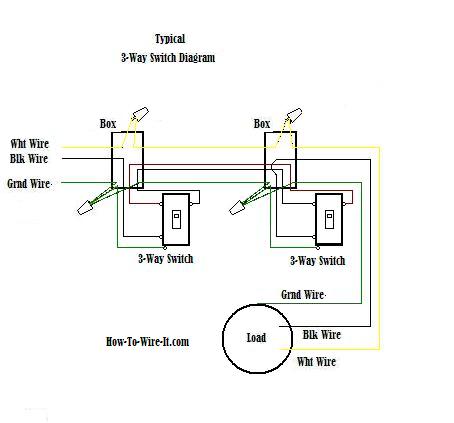
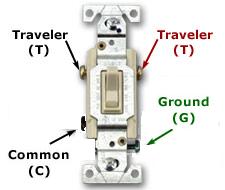
Notice that there is a 3-conductor cable coming into the first box, then a 4-conductor cable going from left box to right box, then a 3-conductor cable going from the right box to the load.
Now for wiring, lets assume you're looking at the switch just like it shows.
The Left Box:
The lower left screw is the common and gets the black wire from the source (3-cond). The upper left screw gets the black wire from the right box (4-cond). The upper right screw gets the red wire from the right box (4-cond). The white wires tie together with a wire nut. The bare copper wires tie together with a wire nut. Be sure to attach a bare copper wire to the green screw on the switch.
The Right Box:
The lower left screw is the common and gets the black wire from the load (3-cond). The upper left screw gets the red wire from the left box (4-cond). The upper right screw gets the black wire from the left box (4-cond). The white wires tie together with a wire nut. The bare copper wires tie together with a wire nut. Be sure to attach a bare copper wire to the green screw on the switch.
The diagram below will give you a good understanding of what this circuit is accomplishing.
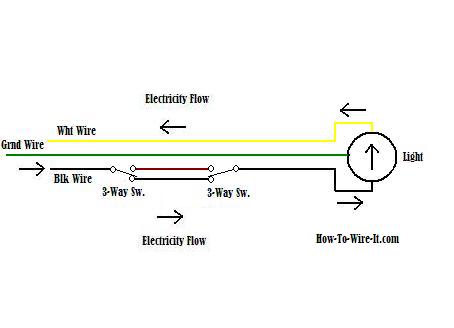
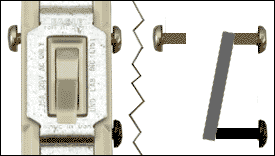
Follow along with the mouse pointer as we go through this. The source power (black wire) is coming in from the left. It ties into the common on the left switch. When the left switch is toggled, it connects to the upper circuit and now the circuit is open at the right switch which turns off the light. Toggle the right switch and it connects to the upper circuit and now closes the path and turns the light back on and so on. Congratulations! on wiring a 3-way circuit.
In my mind wiring is one thing, but to look at a diagram as the one above and understand the principle involved, that is the key to do-it-yourself house wiring.
If you're simply replacing a 3-way switch, the diagrams below will show the different scenarios on how your circuit could possibly be wired.
Is your Situation Like any of the Following Diagrams?
Power-Switch-Switch-Light
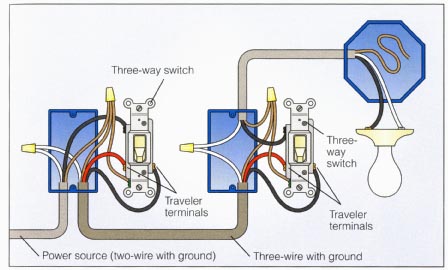
Power-Light-Switch-Switch
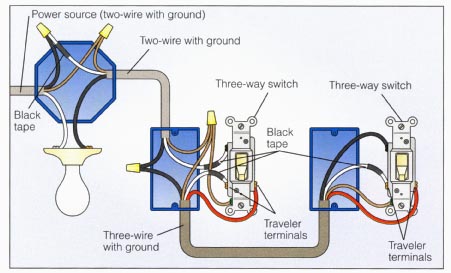
Switch-Light/Power-Switch
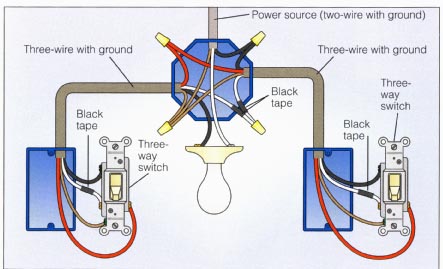
What is common in the diagrams above and with any 3-way switch circuit is that the power hot wire coming into the circuit will always go to the common terminal of the first switch. The hot wire from light always goes to the common terminal of the second switch. The traveler wires go from switch to switch connected to the traveler terminals, it doesn't matter which. As long as you keep this in mind, a 3-way circuit becomes really simplified. And of course the neutral will always go directly to the load.
Allow Tim Carter from AskTheBuilder.com to show you some
great tips for installing and wiring a 3-way switch.
3 Way Switch With2 Black Wires and 1 Red Wire
Source: https://www.how-to-wire-it.com/wiring-a-3-way-switch.html